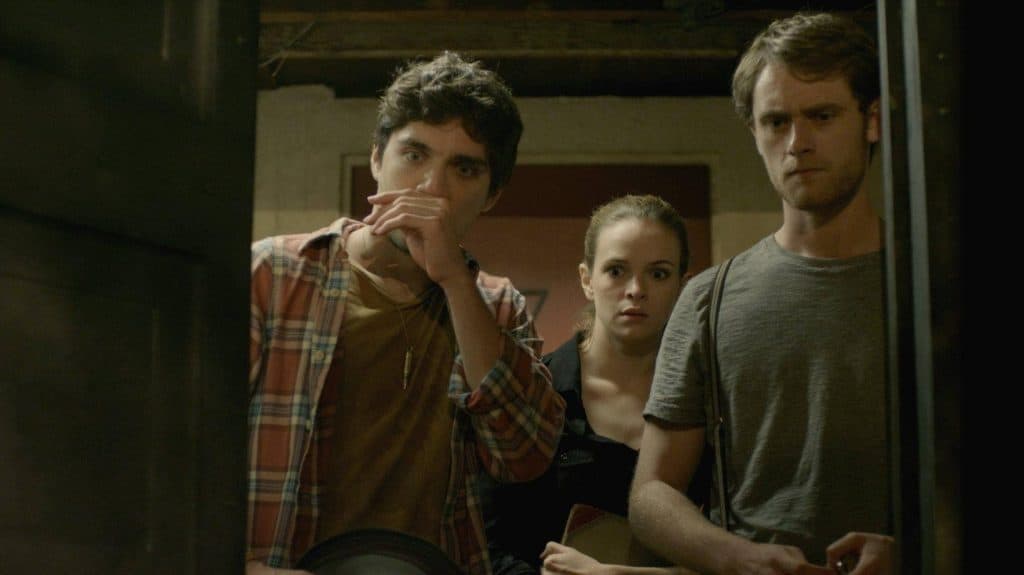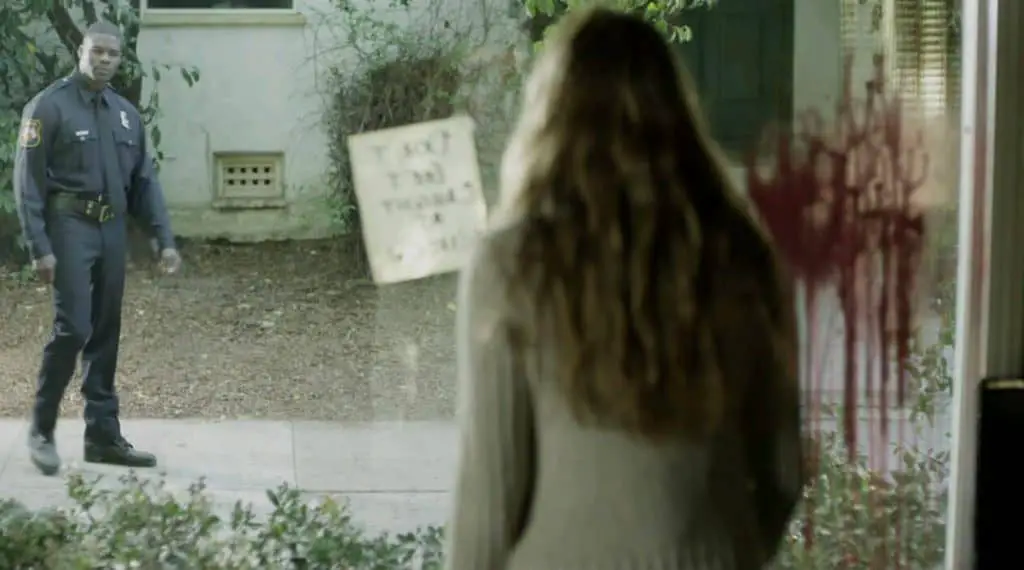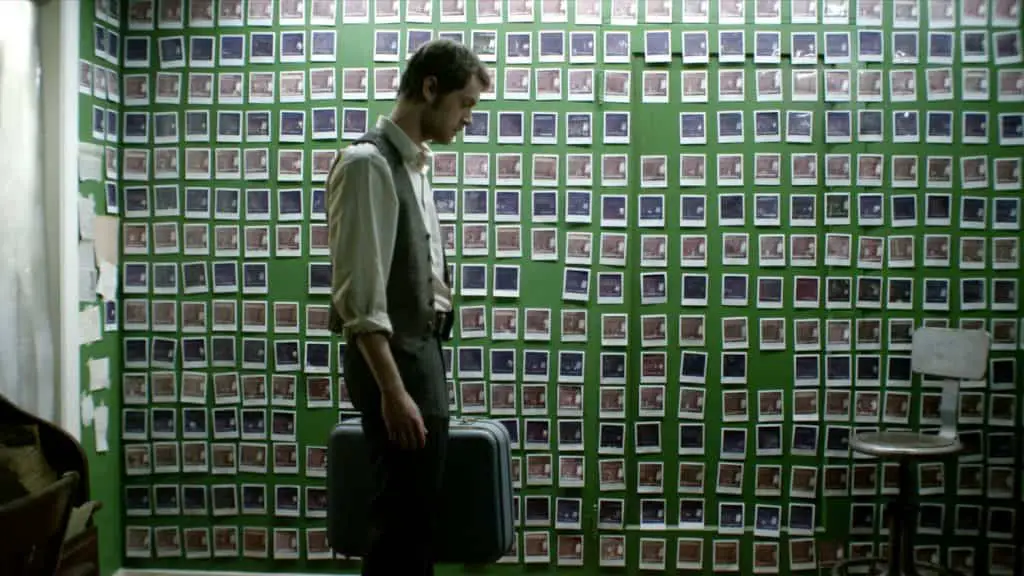The meaning of the film Time Laps
Time Laps is more like a chamber theatrical performance than a sci-fi action. Limited location, minimum of characters, but a lot of dialogue. The time paradoxes are given exactly as much time as it takes to believe in the reality of the plot collision – and no more. The most interesting thing happens not outside, but in the inner world of the heroes.
Indeed, it’s not so hard to believe in a camera that takes pictures of the future than in how cute guys turn into ruthless killers in a week. Since I am explaining the meaning here, I will have to talk about the relationship of the characters, and about the laws of time in the universe of the film. Hope I can answer all the questions you might have while browsing.
What happened to Mr. Bezzerides?
Mr. Bezzerides experimented with his camera and took a snapshot of what would happen in a week. In the picture, he saw that there was a blood stain on the wall of the neighboring living room, and his hat was on the couch. The scientist decided that this was a scene of his murder. He sent the image for safekeeping to his colleague Dr. Heidecker, and in a hurry he came up with a plan to avoid death. What his plan was, we will never know, but in order to carry it out, Mr. B needed to visit his secret laboratory. On the way, he dropped his hat, which Finn would later find. And in the laboratory itself, the scientist had an accident.
Dr. Heidecker: Well, it’s obvious to me: it’s thorium, a radioactive gas, see this wire? I think he stumbled over him, and a canister fell off the shelf – right onto the canister. It’s just an accident, nothing more. I guess he was in a panic because he was trying to avoid this [shows a photo].
Most of the time, the main characters in the film are delusional about what happened to their neighbor. In the last entry in his journal, he mentioned that over time it is not worth playing – this can lead to sad consequences. Therefore, the heroes believe that Mr. B died because of his attempt to interfere with the nature of time. In fact, Mr. B was ruined by haste and imprudence.

Guys think Mr. B was ruined by his games over time
Why do heroes start obeying the camera?
Each of the heroes has a passion that makes them use the camera for their own purposes.
Jasper’s passion is money. He uses the camera to place win-win bets. Jasper does not hide his purpose from the very beginning. He convinces the others to cover up Mr. B’s death, follow prophetic photographs, and make money.
Finn’s passion is creativity, but lacks inspiration. At the beginning of the film, Jasper sneers at the fact that Finn has been sitting in front of a blank canvas for two weeks. The camera for Finn is a conveyor of ideas. At first, Finn opposes Jasper’s proposal, as he is indifferent to money. But over time, Finn also becomes dependent on the camera and can no longer create pictures without prompts from the future.
Callie is a little more complicated. Until the very end, it is not clear to the viewer what benefit Callie gets from interacting with the camera. We know from Jasper that Callie wants to become a writer, but in the meantime she works as a waitress. It would be logical to assume that Callie would use the camera as a source of ideas, like Finn, or for enrichment, like Jasper, so she could quit her job and take up literature. But the girl doesn’t.
It is only in the finale that it becomes clear that Callie’s passion is Finn. He is immersed in creativity and almost does not notice his girlfriend. Callie used the camera to awaken Finn’s feelings. I’ll tell you more about this below.

Jasper’s passion is money
What’s wrong with Finn and Callie’s relationship?
To be honest, I didn’t immediately realize that Callie and Finn were dating – only after Finn called her his girlfriend, which is about half an hour from the beginning of the film. Finn seems to be asleep, and Callie tries to wake him up.
Let’s compare two statements. When Callie poses nude, Finn confesses: “I just woke up and realized what really is in front of me” (original: It needs a moment like this to wake the guy up so he can actually see what ‘ s right in front of him ). In the finale, Callie talks about the night of the charade when she made love to Jasper next to the sleeping Finn: “It seemed like I did it on purpose so that you could catch us” (original: It ‘ s almost asif I wanted to get caught, so you would wake up ).
Both times the same verb was used – wake up , to wake up, although in translation it was lost both times. Callie wants to wake up Finn, and in the end she succeeds. Nearly.
“Today you fought for us like never before,” Callie says admiringly, and Finn is still terrified of what his girlfriend did. She killed Jasper a few minutes ago, but now she only cares that Finn is finally jealous of her. In a couple of minutes she will also kill Finn in order to return to the past and hide her deception and betrayal from him. Yes, it seems that of all the passions of this trio, Callie’s passion is the strongest, and in the finale the girl practically loses her mind because of her.

Some photos on the wall are missing – Callie took them.
Why did Callie shoot Finn?
When Callie found the camera, she had a stack of snapshots from the past week, day and night, next to her. In a fresh daytime photo, she saw her message from the future: “Hide the daytime photos of the last week.” The girl followed the instructions, and also took pictures from the wall in which she makes love to Jasper.
Later, the guys notice that among the photographs on the wall there are daytime and evening ones. Callie casually throws out, “Maybe the camera was only set for one shot in the last week.” From that moment on, she plays a double game, which Finn and the audience will only find out about in the finale.
Finn catches Callie sending messages to the past and asks about everything. Callie confesses to her secret game and explains that she did it in order to revive their relationship. She thinks the plan was a success, but Finn is horrified. He wants to leave and destroy the car. To prevent him from doing this, Callie kills Finn and then tries to change the past.
Callie’s secret correspondence from the present with Callie from the future gave the girl a false sense of power over time. Callie has never tried to change the past, which means she cannot know for sure that this is possible. Nevertheless, in the finale, she is absolutely sure that she will be able to “cancel” all the events of the last day if she changes the image in the daytime photograph.
But in the universe of the film, this is not possible. The hero can look into the future, but he cannot change the past. Callie doesn’t realize this when she shoots Finn. She is driven by the only desire – not to let her boyfriend destroy the time machine. After that, she writes herself a note: “Don’t get caught at the window,” referring to the moment when Finn found her taking pictures with messages to the past. If the camera takes a picture of the note, Finn will not know her secrets in the past, they will not quarrel and everything will be as she wanted.
Appreciate the depth of irony: Callie writes “Don’t get caught at the window,” and with this note she comes across at the window for the second time. This time the girl’s plans are violated by Big Joe. He sees blood on the wall, a strange note on the glass, and asks permission to enter. Callie calmly lets him lead her away, because she is sure that now the camera will take a picture, and at the same moment the past will change and the present will be canceled. But the note, glued to one strip of tape, comes off and falls. Callie runs back in horror, but it’s too late – the camera has managed to take a picture. The present is unchanged, and Callie is in jail.

Callie is caught at the window with a note “Don’t get caught at the window”
What laws does time obey in the film universe?
Self-fulfilling prophecy
In Time Laps universe, anyone can find out their future, only this future already includes the consequences of the fact that the hero knew him in advance. To understand how this works, you need to become familiar with the concept of self-fulfilling prophecy.
Self-fulfilling prophecy is the name of a well-known temporary paradox, which is that a certain prediction affects reality in such a way that it leads to its fulfillment. A classic example of self-fulfilling prophecy is the Oedipus myth.
The oracle predicted to Oedipus’s father that he would die at the hands of his own son. Therefore, the newborn boy was taken to the mountains and thrown there. Oedipus was picked up and raised by a shepherd. When Oedipus grew up, he learned from the pythia that it was written to him to kill his father and marry his mother. Thinking that his parents were shepherds, Oedipus left home and ended up in Thebes, where his real father ruled. Not knowing this, Oedipus killed the king, and later he himself became the ruler of Thebes, and his mother-queen became his wife. It turns out that the prophecy forced the father of Oedipus and Oedipus himself to make such decisions that led to the fulfillment of the prophecy.
All the pictures taken by the camera from the moment they fall into the hands of the heroes are self-fulfilling prophecies. All the decisions of the heroes lead to one thing – the one depicted in the photo will definitely come true, regardless of whether they tried to repeat the situation in the photo or avoid it.
For example, when Jasper sees Ivan in the frame, he realizes that the bookie has no reason to come to his house. But Jasper is afraid to deviate from the prediction and calls Ivan, which attracts too much attention and provokes the bookmaker to pay him a visit.
Reverse example: Mr. Bezzerides is trying to prevent what is shown in the photo (blood stain on the wall, his hat on the couch). But all his actions inevitably lead to this: starting with the fact that Mr. B loses his hat (this is the only way she could end up in the guys’ living room) and ending with the death of a scientist (otherwise the neighbors would not find the camera).

Heroes believe to the last that deviation from predictions is tantamount to death. Therefore, Finn himself does not believe that he will be able to leave.
Causal loop
A causal loop is a chain of events in which a cause is both an effect and it is impossible to find the “very first” cause. The easiest way to understand this is with the example of Finn and his paintings. In pictures from the future, Finn sees his pictures already drawn, and he does not have to come up with ideas for them. He is simply copying his own creativity from the future. So Finn painting a picture in the future is both a cause and a consequence of Finn painting a picture in the present. Then at what point did Finn come up with the idea for the painting? .. This moment is lost in a causal loop.
What does Finn’s painting mean?
One of the first pictures that Finn writes is a spiral that pours out of something that resembles a beer bottle. The spiral in the picture and the numbers on the dial scattered around it symbolize the passage of time in the film. The bottle is a hint of Callie’s betrayal. In the finale, she confesses that she slept with Jasper while getting drunk. And at the moment when Finn paints this picture, Callie kisses with Jasper, after taking a couple of sips from the bottle.
What does the mechanical clock in the living room represent?
It seems to me that the watch is an iconic detail. They invariably appear in every photo of the living room and serve as a kind of guarantor of order. Glancing at his watch, Finn understands how to finish the picture, and draws the numbers on it. The clock symbolizes the linear movement of time.
When Ivan first comes to the kids’ house, he breaks the clock with his bat. It is from this moment that the relations of the heroes begin to deteriorate. The symbol of linear time – a mechanical clock – is broken, the heroes are caught in a spiral, from which there is no way out. Broken clocks are replaced with electronic ones, and together with them the comfort seems to leave this house.







